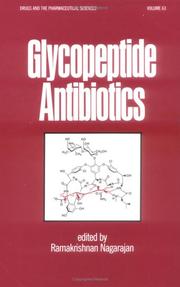| Listing 1 - 4 of 4 |
Sort by
|

ISBN: 0824791932 Year: 1994 Publisher: New York (N.Y.) : Dekker,
Abstract | Keywords | Export | Availability | Bookmark
 Loading...
Loading...Choose an application
- Reference Manager
- EndNote
- RefWorks (Direct export to RefWorks)
Glycopeptide antibiotics. --- Antibiotics, Glycopeptide. --- Vancomycin.
Book
ISBN: 9175190966 Year: 2015 Publisher: Linköping, Sweden : Linköping University,
Abstract | Keywords | Export | Availability | Bookmark
 Loading...
Loading...Choose an application
- Reference Manager
- EndNote
- RefWorks (Direct export to RefWorks)
Infection --- Methicillin resistance. --- Vancomycin resistance. --- Prevention.
Periodical
ISSN: 16841182
Abstract | Keywords | Export | Availability | Bookmark
 Loading...
Loading...Choose an application
- Reference Manager
- EndNote
- RefWorks (Direct export to RefWorks)
Microbiology --- Allergy and Immunology --- Immunity --- Infection --- Communicable Diseases --- Communicable diseases --- Microbiologie --- Immunité --- Maladies infectieuses --- Periodicals. --- Périodiques --- Microbiology. --- Allergy and Immunology. --- Immunity. --- Infection. --- Communicable Diseases. --- Communicable diseases. --- Agriculture Sciences --- Health Sciences --- Life Sciences --- Soil Chemistry, Microbiology, Fertility & Fertilizers --- Allergy --- Immunology --- Micro and Molecular Biology --- bacteremia --- pneumonia --- vancomycin --- infection --- mycobacterium --- General microbiology
Book
ISBN: 3039287850 3039287842 Year: 2020 Publisher: MDPI - Multidisciplinary Digital Publishing Institute
Abstract | Keywords | Export | Availability | Bookmark
 Loading...
Loading...Choose an application
- Reference Manager
- EndNote
- RefWorks (Direct export to RefWorks)
Nanocelluloses: Synthesis, Modification and Applications is a book that provides some recent enhancements of various types of nanocellulose, mainly bacterial nanocellulose, cellulose nanocrystals and nanofibrils, and their nanocomposites. Bioactive bacterial nanocellulose finds applications in biomedical applications, https://doi.org/10.3390/nano9101352. Grafting and cross-linking bacterial nanocellulose modification emerges as a good choice for improving the potential of bacterial nanocellulose in such biomedical applications as topical wound dressings and tissue-engineering scaffolds, https://doi.org/10.3390/nano9121668. On the other hand, bacterial nanocellulose can be used as paper additive for fluorescent paper, https://doi.org/10.3390/nano9091322, and for the reinforcement of paper made from recycled fibers, https://doi.org/10.3390/nano9010058. Nanocellulose membranes are used for up-to-date carbon capture applications, https://doi.org/10.3390/nano9060877. Nanocellulose has been applied as a novel component of membranes designed to address a large spectrum of filtration problems, https://doi.org/10.3390/nano9060867. Poly(vinyl alcohol) (PVA) and cellulose nanocrystals (CNC) in random composite mats prepared using the electrospinning method are widely characterized in a large range of physical chemical aspects, https://doi.org/10.3390/nano9050805. Similarly, physical chemical aspects are emphasized for carboxylated cellulose nanofibrils produced by ammonium persulfate oxidation combined with ultrasonic and mechanical treatment, https://doi.org/10.3390/nano8090640. It is extraordinary how nanocellulose can find application in such different fields. Along the same lines, the contributions in this book come from numerous different countries, confirming the great interest of the scientific community for nanocellulose.
tensile strength --- amino acid --- poly (vinyl alcohol) --- Eu ion --- recycled fiber --- bacterial nanocellulose --- Fenton reagent --- cross-linking --- electrospinning --- biomedical applications --- complex --- fluorescent paper --- nanocomposite --- vancomycin --- reinforcement --- carbon source --- in situ modification --- facilitated transport --- water application --- scanning electron microscopy --- nanocellulose --- cellulosic fiber --- rheology --- polymer nanocomposites --- selective separation --- durability --- oxidation --- thermogravimetric analysis --- ex situ modification --- methacrylate --- nanofibrils --- bacterial cellulose --- ammonium persulfate --- high shear mixer --- ionic liquid --- tensile properties --- bioactive bacterial nanocellulose --- gas separation membranes --- CO2 separation --- dispersion --- cellulose nanocrystals --- ciprofloxacin
| Listing 1 - 4 of 4 |
Sort by
|

 Search
Search Feedback
Feedback About UniCat
About UniCat  Help
Help News
News